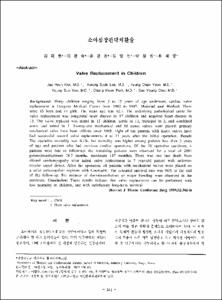KUMEL Repository
1. Journal Papers (연구논문)
1. School of Medicine (의과대학)
Dept. of Thoracic & Cardiovascular Surgery (흉부외과학)
소아심장판막치환술
- Alternative Author(s)
- Kim, Jae Hyun; Lee, Kwang Sook; Yoo, Young Sun; Park, Chang Kwon; Choi, Sae Young
- Journal Title
- 대한흉부외과학회지
- ISSN
- 0301-2859
- Issued Date
- 1999
- Keyword
- Child; Heart valve replacement
- Abstract
- Background: Thirty children ranging from 3 to 15 years of age underwent cardiac valve replacement at Dongsan Medical Center from 1982 to 1997. Material and Method: There were 16 boys and 14 girls. The mean age was 12.1. The underlying pathological cause for valve replacement was congenital heart disease in 17 children and acquired heart disease in 13. The valve replaced was mitral in 15 children, aortic in 11, tricuspid in 3, and combined aortic and mitral in 1. Twenty-one mechanical and 10 tissue valves were placed: primary mechanical valve have been utilized since 1985. Eight of ten patients with tissue valves have had successful second valve replacements 4 to 11 years after the initial operation. Result: The operative mortality was 6.7%, but mortality was higher among patients less than 5 years of age and patients who had previous cardiac operations. Of the 28 operative survivors, 4 patients were lost to follow-up: the remaining patients were observed for a total of 2091 patient/months(mean 74.7 months, maximum 187 months). There was one late death from dilated cardiomyopathy after mitral valve replacement in 7 year-old patient with atrioventricular septal defect. After the operation, all patients with mechanical valves were placed on a strict anticoagulant regimen with Coumadin. The actuarial survival rate was 96% at the end of the follow-up. No instance of thromboembolism or major bleeding were observed in the survivors. Conclusion: These results indicate that valve replacement can be performed with low mortality in children, and with satisfactory long-term survival.
배경: 소아에서의 심장판막치환술은 성인에서의 심장판막치환술의 제반문제 이외에도 작은 판막의 혈류역학적 문제, 신체발육에 따른 재수술, 출산 및 항응고요법에 따른 여러 문제점이 있다. 이에 본 연구에서는 계명대학교 동산의료원 흉부외과에서 경험한 심장판막치환술에 대하여 후향적 조사를 실시하여 소아 심장판막치환술의 여러 문제점과 해결책을 규명하려 하였다. 대상 및 방법: 1982년부터 1997년까지 15세 이하 소아 30명에서 심장판막치환술을 시행하였다. 남아가 16명, 여아가 14명이었으며, 연령 분포는 3세에서 15세로 평균 연령은 12.1$\pm$ 수식 이미지3.2세 였다. 판막 부위별로 보면 승모판치환술 15례, 대동맥판치환술 11례, 삼첨판치환술이 3례였으며, 승모판 및 대동맥판치환술이 1례 있었다. 판막질환의 원인을 보면 선천성이 17명, 후천성이 13명이었다. 이용한 판막으로는 조직판막 10례, 기계판막 20례였으며 1985년 이후로는 조직판막은 사용하지 않았다. 기계판막치환 환자에서는 술후 coumadin으로 항응고치료를 지속하였으며, 조직판막치환 환자에서는 술후 3개월간 coumadin을 복용하였다. 판막치환술 이전에 심장수술을 받은 환자는 8명으로 엡스타인씨기형 교정술 2례, 심실중격결손증과 대동맥폐쇄부전의 교정술 2례가 있었으며, 그 외 대동맥판막하협착, 방실중격결손증, 대동맥판협착증 및 심실중격결손증 등의 교정술이 각각 1례씩 있었다. 판막치환시 동시에 시행한 술식으로는 삼첨판륜성형술 3례, 심실중격결손증 교정 2례, 동맥관개존증 결찰 2례, 대동맥판륜확장술 2례, 심실중격결손증과 동맥관개존증 교정 1례, 승모 풉낮첬括珝낵\ulcorner1례등이 있었다. 결과: 수술사망은 2례로 조기사망률은 6.7%였다. 수술생존자 28명중 4명은 장기추적관찰이 불가능하였으며, 총 2091환자.월(평균 74.7$\pm$ 수식 이미지68.4개월, 최장 187개월)동안 관찰하였다. 이 기간중 판막의 혈전, 혈전색전증 및 항응고치료에 따른 출혈등의 합병증은 없었으나, 조직판막을 이용한 10례중 8례에서 술후 평균 87.1$\pm$ 수식 이미지23.6개월에 판막기능부전으로 재수술하였으며(이중 2례는 타 병원에서 수술함), 기계판막을 치환한 1례에서 판막주위누출과 감염으로 술후 3개월째 재수술하였다. 재수술시 사망례는 없었다. 만기사망은 1례로 방실중격결손증 교정술후 잔존 승모판폐쇄부전으로 승모판치환술을 받은 7세환아로 판막치환술후 4개월에 확장성심근염으로 사망하였다. 조직판막의 경우 생명표분석에 의한 판막실패가 없는 장기누적률은 6년째 75.0%, 7년째 50.0%, 8년째 12.5%의 기록을 보여 술후 6년에서 8년에 걸쳐 격감하는 양상을 보였다. 수술사망 2례를 제외한 28명의 장기생존률을 Kaplan-Meiyer법에 의해 분석하였을때 4개월째 생존률이 96.0%로 그 이후로는 사망례가 없었다. 결론:이상의 결과로 보아 소아 심장판막치환술은 비교적 안전하고, 술후 적절한 추적관찰이 행해질 경우 항응고요법에 따른 합병증은 거의 없으나, 5세이하 소아나 판막치환술 이전에 심장수술을 한 경우는 위험도가 여전히 높은 것으로 사료된다.키워드: 소아; 심장판막치환술 ;
- Alternative Title
- Valve Replacement in Children
- Publisher
- School of Medicine
- Citation
- 김재현 et al. (1999). 소아심장판막치환술. 대한흉부외과학회지, 32(4), 341–346.
- Type
- Article
- ISSN
- 0301-2859
- Appears in Collections:
- 1. School of Medicine (의과대학) > Dept. of Thoracic & Cardiovascular Surgery (흉부외과학)
- 파일 목록
-
-
Download
 oak-bbb-5432.pdf
기타 데이터 / 350.74 kB / Adobe PDF
oak-bbb-5432.pdf
기타 데이터 / 350.74 kB / Adobe PDF
-
Items in Repository are protected by copyright, with all rights reserved, unless otherwise indicated.